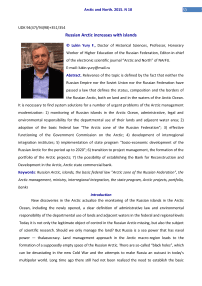Russian Arctic increases with islands
Автор: Lukin Yury F.
Журнал: Arctic and North @arctic-and-north
Рубрика: Social science. Political science. Economics
Статья в выпуске: 18, 2015 года.
Бесплатный доступ
Relevance of the topic is defined by the fact that neither the Russian Empire nor the Soviet Union nor the Russian Federation have passed a law that defines the status, composition and the borders of the Russian Arctic, both on land and in the waters of the Arctic Ocean. It is necessary to find system solutions for a number of urgent problems of the Arctic management modernization: 1) monitoring of Russian islands in the Arctic Ocean, administrative, legal and environmental responsibility for the departmental use of their lands and adjacent water area; 2) adoption of the basic federal law "The Arctic zone of the Russian Federation"; 3) effective functioning of the Government Commission on the Arctic; 4) development of interregional integration institutes; 5) implementation of state program "Socio-economic development of the Russian Arctic for the period up to 2020"; 6) transition to project management, the formation of the portfolio of the Arctic projects; 7) the possibility of establishing the Bank for Reconstruction and Development in the Arctic, Arctic state commercial bank.
Russian Arctic, islands, the basic federal law "Arctic zone of the Russian Federation", the Arctic management, ministry, interregional integration, the state program, Arctic projects, portfolio, banks
Короткий адрес: https://sciup.org/148318742
IDR: 148318742 | УДК: 94(47)/94(98)+351/354
Текст научной статьи Russian Arctic increases with islands
New discoveries in the Arctic actualize the monitoring of the Russian islands in the Arctic Ocean, including the newly opened, a clear definition of administrative law and environmental responsibility of the departmental use of lands and adjacent waters in the federal and regional levels Today it is not only the legitimate object of control in the Russian Arctic missing, but also the subject of scientific research. Should we only manage the land? But Russia is a sea power that has naval power — thalassocracy. Land management approach in the Arctic macro-region leads to the formation of a supposedly empty space of the Russian Arctic. There are so-called “black holes”, which can be devastating in the new Cold War and the attempts to make Russia an outcast in today's multipolar world. Long time ago there still had not been realized the need to establish the basic federal law on the subject of governance, composition, status, the boundaries of the Russian Arctic, including the waters.
Arctic management includes state and municipal management, strategic, project management of the changes in the Russian Arctic. The concepts of the “Arctic zone of the Russian Federation” and the “Russian Arctic” are used in the text of the article as identical. Scientific methods of research, (analysis, synthesis), and the methods of individual scientific disciplines (history, management, geopolitics) are used as well. Abbreviations: the Arctic zone of the Russian Federation — AZRF, the Arctic Ocean — AO, the North Sea Route — NSR, a federal law — FL, municipalities — MO, special economic zone — SEZ, oceanographic research vessel —ORV, Ministry of Foreign Affairs — MFA, Franz Josef Land —FJL, United Nations Convention on the Law of the Sea —- UNCLOS.
New Russian island in the Arctic Ocean
In the 21st century in the Arctic centuries glaciers are melting and previously known islands begin appear. Russia starts to grow with islands in the Arctic Ocean that increase the territorial waters of Russia, its special economic zone (SEZ)1. The crew of the transport helicopter Mi-26 in 2013 carried the loads from the Arctic port of Tiksi, Yakutia to Kotelny Island (New Siberian Islands), where an Arctic military base was created and the airfield "Temp" was restored. Along the way, the pilots noticed a small piece of land not marked on maps. The commander assistant of the Mi-26 Vitaly Mikhalchuk said that the island was called Yaya because everyone started shouting: “This is me, I found it!” In winter the island was not visible. And then it stood up as if from the depths. So the helicopter crew increased the area of Russia, even for a few hundred square meters”2.
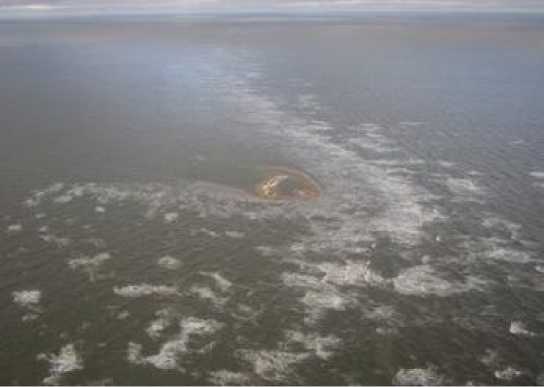
Picture 1.Yaya Island.
To confirm or refute the geographical discovery had become possible only a year later. In August 2014 the oceanographic research vessel (ORV) of the Baltic Fleet, “Admiral Vladimir” came from Kronstadt, seaworthiness of which is able to ensure a safe navigation in all seas and oceans. In January 18, 2015 after five months navigation the ship returned to Kronstadt. The expedition found out that Gulf of Krivoshein of the Novaya Zemlya archipelago was actually a strait, documented the formation of a new cape, collapse and retreat of glaciers on average of four to five kilometers inland. The other merits of the crew was the correction of maps that confirmed the discovery of the Yaya island, located in the Laptev Sea and had not previously shown on the map. In general, the expedition had found about two dozen new geographical objects3.
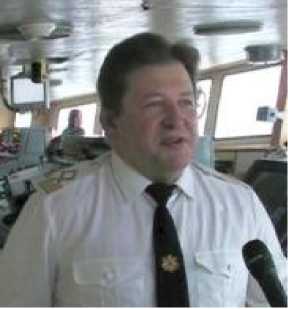
Picture 2.Captain Alexandr Pyshkin
meter above sea. Members
The captain of the ship was a hereditary seaman, Captain of the 1st rank reserve Alexander Vyacheslavovich Pyshkin. The ORV crew managed to land on the island of Yaya and determine its exact coordinates. The island is a small sandbank area of about 500 square meters. The island rises to a height of not more than a of the expedition on the “Admiral Vladimir” managed not only to confirm the discovery made by Khabarovsk pilots, but also to map several objects: new islands in the Novaya Zemlya area, straits and capes. The “white spots” of the Chukchi Sea were explored, the expedition measured the depth to determine the best way along the Northern Sea Route 4.
Last time such a detailed study of the Arctic in Russia was held a hundred years ago. In the midst of World War I Russia's Foreign Ministry has asked the governments of allied and friendly countries with a note about the ownership of all the lands and islands located North of the Asiatic coast of the Russian Empire discovered for centuries by the efforts of Russian sailors and merchants.
Research and geographical discoveries of Russian sailors were replenished by the success of the hydrographic expedition 1913—1915 on two icebreakers “Taimyr” and “Vaigach”, headed by a young naval officer, hydrographer, Captain of the II rank Boris Vilkitsky (1885—1961). During the expedition several new islands were discovered: Severnaya Zemlya (Nicholas II Land), Malyi Taimyr, Starokadomsky island and Zhokhov island.
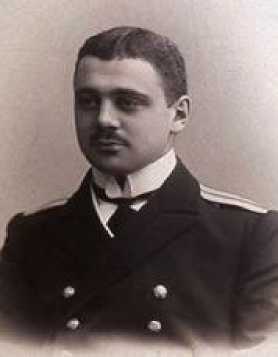
Picture 3. Captain B.A. Vilkitsky
The maps and sailing directions of the highest quality were made, the biological, botanical and zoological research was done and the important geographical discoveries were made.
On September 16, 1915 the first through sailing the North-East way from the East to the West was completed. The members of the expedition were met in Arkhangelsk on the Cathedral pier attended by all the civil and military provincial authorities. A year after the end of the expedition the formal recognition of the discovered territory of the Russian Empire was made.
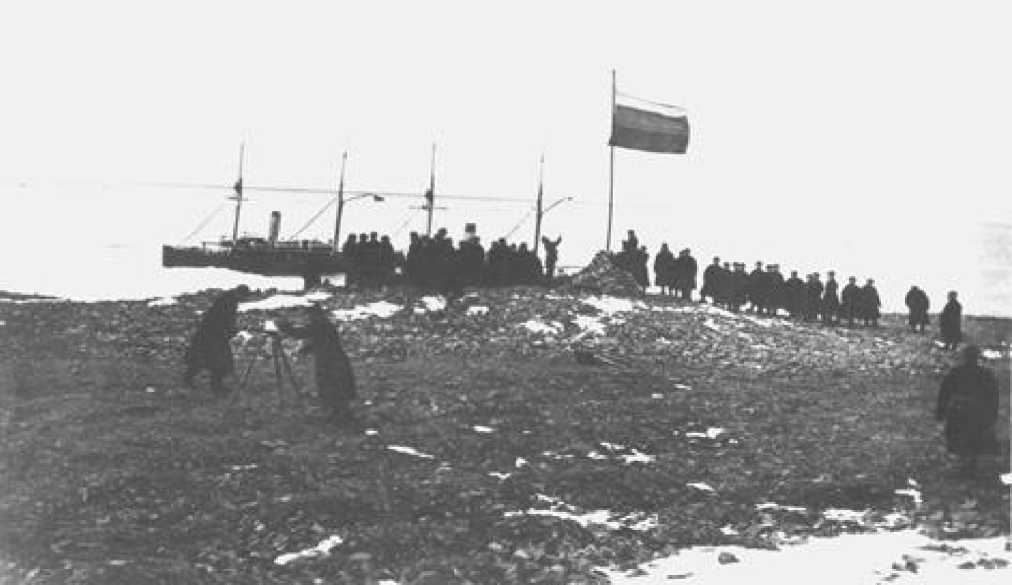
Picture 4. The rise of the Russian flag on the Nickolas II Land (Northern land).N.I. Evgenov’s archive. URL:
The Russian government has informed the Government of allied and friendly nations by the note dated 20.9.1916 on the inclusion of these lands into the Russian Empire and claimed that it considered the island of Henrietta, Jeanette, Bennett, Gerald and Yedineniya together with the islands of Novosibirsk, Wrangel and the other located near the Asian coast, continued up to the north of the continental space of Siberia 5 a part of the Empire. The Russian government had not considered the inclusion of the island of Novaya Zemlya, Vaigach and other various sized islands, located near the European coast of the empire, citing the fact that they had belonged to the empire wand were widely recognized by the other states for centuries. The map of the Arctic with the designation of all these territories and water areas was attached to this note.
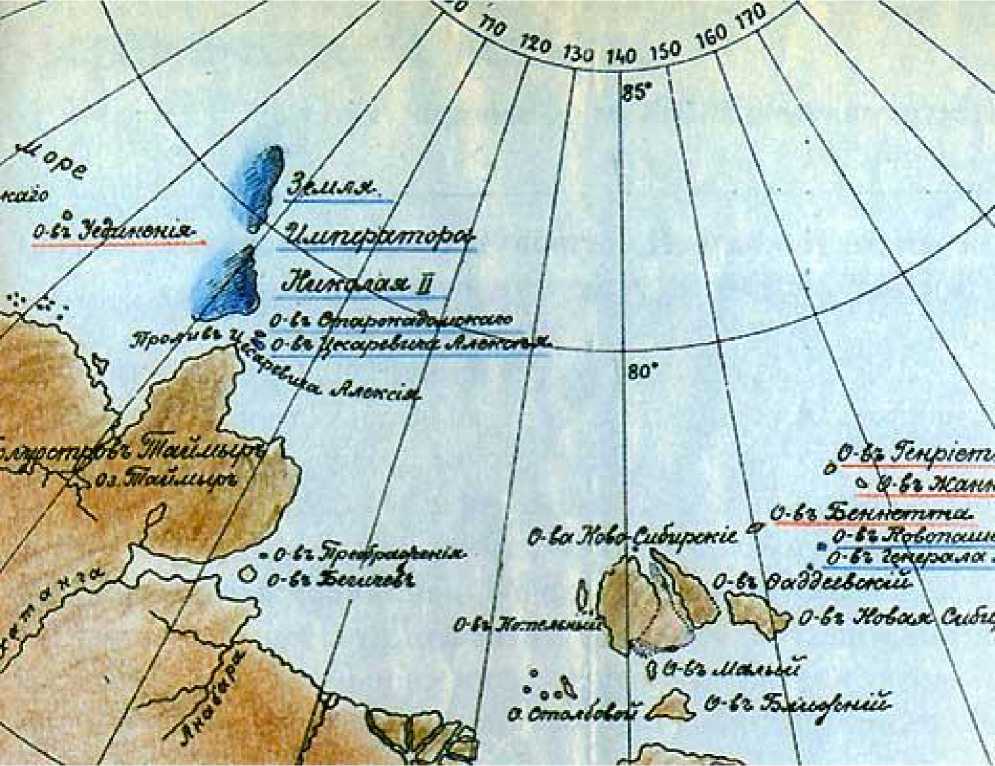
Picture 5. URL:
The value of the MFA notes is extremely large and significant. Russia acted as a collector of lands in the harsh Arctic Ocean. Not only the lands along the European and Asian coasts, but also all the islands in the cold ocean, where even signs of hydrocarbon resources had not yet been found, were declared a part of the Russian Empire. None of the countries in the world, and it was the First World War going on, made any objections to this act.
In the 21st century another new island appeared in an archipelago of the Franz Josef Land. The existence of the 192nd island of FJL had been known since 1985. All attempts to legitimize the new island failed for one reason or another. 28 years ago the historical and archaeological expedition on the icebreaker “Kapitan Dranitsin” went to the island of Northbrook in the SouthWest of the archipelago. And on the first day after the landing on the island the crew of Captain
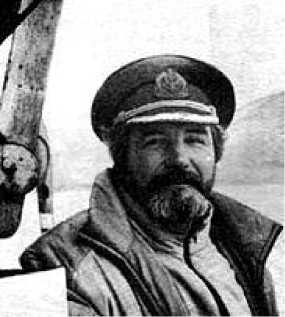
Picture 6. Captain Rostislav Gaydovsky
Rostislav Rostislavovich Gaydovsky6 discovered and explored previously unknown sea strait separating the island into two unconnected pieces of land. The expedition decided to give the strait the name of the discoverer — Gaydovsky Strait and the islands were called West Northbrook and East Northbrook [1]. Two decades later, in 2006, the division of the island into two parts by a strait was confirmed by Stanislav Rumyantsev —skipper of the atomic icebreaker “Yamal”
that carries out regular tourist cruises to the North Pole.
In summer 2007, the Norwegian Børge Ousland together with the Swiss Thomas Ulrich followed in the steps of Fridtjof Nansen and Hjalmar Johansen from the polar region through the Franz Josef Land to Cape Flora, the island of Northbrook. They also noticed the island and sent a letter to the Russian Embassy in Norway with a statement on the opening of a new island in the archipelago. In addition, they complained that the map of the archipelago had only few names Norwegians and suggested the naming of the island after Hjalmar Johansen.
Franz Josef Land was also visited by the high-latitude expedition of the Arctic and Antarctic Research Institute, headed by Vladimir T. Sokolov. In 2012 the hydrographs produced all the necessary measurements, fixed the coastal line coordinates with the use of satellite navigation system, and made the leveling shooting [1].
Significant step towards the official recognition of a new island was made in the summer of 2013 during the expedition of the National Park “Russian Arctic” when it was possible to make the initial description of the strait, to pass along its shores to the west and east coast, to get the GPS-coordinates, to take photos and make the description of the coast and to learn the navigational features of the strait.
Availability of the strait and the existence of the 192nd island of the Franz Josef Land were again confirmed during the arctic expedition in August—September 2014 on the yacht “Apostol Andrey” (Captain — Nickolai Litau). The member of the expedition A.P. Oboimov emphasized that the strait was actually through, and the water flow evidenced for it in [2].
But now the discovery of the island cannot be considered as the completed one. To complete the process it is must get the official name. The session of the Arkhangelsk Oblast Council of Deputies approved by its decision on the 26th of November 2008 № 2067 the proposal of the Federal State Institution “Russian State Museum of Arctic and Antarctic” the assignment of the name “Yuri Kuchiev” for the geographic area — the island separated from the south-western part of the Northbrook of the Franz Josef Land archipelago and sent a package of documents to the Federal Agency of Geodesy and Cartography for the preparation of their submission to the Government of the Russian Federation. It was stated that this resolution should take effect from the date of its adoption, although the decision of the regional parliament on such a question was not legitimate7. It is the task of the Commission on Geographical Names to coordinate the establishment, use, registration, accounting and preserving the geographical names8. After registration the Head of the Department of Navigation and Oceanography of the Russian Defense Ministry (SPb) specified and published nautical charts9. Lands registered are proceeded further by the branch of the State Organization “Federal Cadastral Chamber of the Federal Service for State Registration, Cadastre and Cartography” (FCC “Rosreestr”) in the Arkhangelsk region and Nenets Autonomous District”10. Why could not the current system of registration work for so long? — It is not quite clear. But this story has some ethical issues as well.
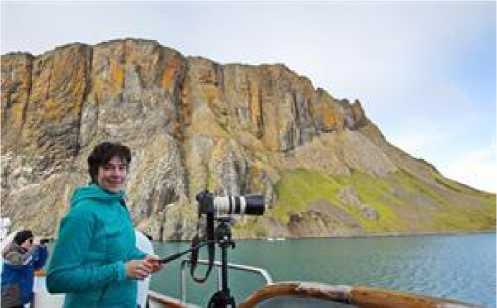
In addition to the established order of registration there was a conflict situation with the new name of the island and the strait. “And I am convinced that the right to name the island and the strait should be left for their discoverers, in addition to the “triumph of justice” and certainly I should consolidate and give the priority of our country in this discovery"— says Maria Vladislavovna Picture 7. Maria Vladimirovna Gavrilo
Gavrilo, Candidate of Biological Sciences, Deputy
Director for Research of the National Park “Russian Arctic”11.
The initial decision of the expedition of Dmitry Kravchenko was to call the Islands West and East Northbrook, and the Strait — in honor of Rostislav Rostislavovich Gaydovsky, decent man, an experienced sea captain with a great navigation experience in the Arctic seas [3]. The representatives of the National park “Russian Arctic” do not exclude the possibility of further discoveries of new islands in the Franz Josef Land archipelago in relation to the global climate change.
The discovery of new islands in the Russian Arctic has not only the obvious scientific importance but geopolitical importance as well, the increase of the Arctic ownership of our country by peaceful means on the basis of the UN Convention on the Law of the Sea (1982), without expansion, the seizure of foreign lands and waters in the Arctic Ocean. Although the island Yaya, for example, it's a tiny piece of land of 500 m2 (5 acres of land —like a small suburban area near a cottage), it pushes the limits of territorial waters (coastal marine band width of 12 nautical miles) deep into the Russian Arctic. The exclusive economic zone of the Russian Federation (the width of the EEZ may not exceed 200 nautical miles = 370.4 miles from the baselines) increases. The captain of the oceanographic research ship “Admiral Vladimir” A.V. Pyshkin showed on the map how the territory of Russia had changed due to the discoveries of the new islands in the ocean. “As a result of the fact that it was an island, the main reference line goes through the island Stolbovoi, Island Yaya, and then down there, and this is now the approximate distance — about 550 square kilometers”, — he explains12.
Drawing conclusions from the story about the registration of new discoveries it seems to be relevant to do the monitoring of all existing islands in the Russian Arctic. Who is responsible for the control of the island, its departmental use on a permanent or temporary basis? What is the administrative and legal and environmental responsibility for the land of the island and its surrounding waters? These are not idle questions. Should there be one more general cleaning of Arctic islands after their departmental use? Must there be published a full list of all the Russian islands in the seas of the Arctic Ocean (including the White Sea) with the definition of their functionality and owner, entrusted to manage these islands by the Russian government with the regard to the certain requirements, rules and regulations. It could be approved by the law “State
Register of Russian islands in the seas of the Arctic Ocean” which indicates the actual status of the Arctic islands, their departmental affiliation and specific responsibility of the land owner.
It makes sense, firstly , if we create municipal settlements on the islands, with at least some amount of permanent or temporary population. There are several models of organizing and managing of such administrative-territorial formations. In the municipality's urban district “Novaya Zemlya” in Arkhangelsk region includes the entire archipelago of the same name. On the 01.07.2013 there lived 2,623 people there13. This municipality was formed in 1997—1999 as a result of long hard work of leadership of the Arkhangelsk region (A.A. Efremov, V.I. Kalyamin) with the active support of the local community. The municipality “Rural settlement Solovetskoe”, a part of the Primorsky Municipal District of the Arkhangelsk region, is located on eight islands in the White Sea and includes 11 villages. Solovki are governed in accordance to the time-innovative management model based on a strategic partnership of the Russian Orthodox Church (Solovetsky Monastery), federal agencies (Solovetsky Museum), regional authorities (Government of the Arkhangelsk region), Primorsky Municipal District and the rural settlement “Solovki” itself. The municipality “Urban settlement Dixon” is included into the Taimyr Dolgan-Nenets Municipal District of the Krasnoyarsk Territory. The northern boundary of the “Urban settlement Dixon” lies within the waters of the Arctic Ocean and covers the northern part of Eurasia — the Taimyr Peninsula, the Severnaya Zemlya archipelago, Sedov, Nordenskjold and a group of islands in Kara and Laptev Seas14 and surrounding waters. Apparently, the experience of these municipalities, the management model could also be used in the other inhabited islands of the northern seas.
Secondly , it is important to determine the status, mission, legal and ethical responsibility for the polar explorers, meteorologists and specialized stations, temporary settlements of a shift type (offshore platforms), closed military areas and military units of the Russian Defense Ministry, frontier posts of the Border Service of the Federal Security Service of Russia and etc. It is necessary to fill the legal gaps and analyze the existing legal acts and practices. On the island Kotelny of the Siberian Islands archipelago, for example, the airfield “Temp” was restored. Meanwhile, we are talking here not only about the important tasks of the Ministry of Defense of the Russian Federation (who would mind it), but also about the administrative, legal, environmental responsibility over island territories, surrounding waters and the corresponding external control. In order not to damage the ecology it is necessary not to contaminate the Russian Arctic with abandoned equipment and barrels with the remnants of fuel, as it was done in the recent past.
Even today it should not be created the unnecessary environmental “hot spots” in the Russian Arctic, and then spend a lot of budgetary resources for the general cleaning of polluted waters and island territories in the Arctic. Ecological imperative is very significant for future generations. Probably the identification and other vital functions for this kind would help the departmental Arctic island settlements, including all types of temporary settlements, offshore platforms for the exploration and production of oil and gas in the Barents, Kara, Pechora and other northern seas.
Thirdly , in the Russian Arctic there are positive conservation practices on the Islands and in adjacent waters, which are parts of national parks, protected areas, nature reserves, that let to adjust the flow of tourists to maintain the natural environment and cultural heritage. The objectives of the National Park “Russian Arctic” include, for example, the preservation of cultural, historical and natural heritage of the Western Sector of the Russian Arctic. “There is an urgent task of cleaning the territory — the legacy of the Soviet era of the development of high latitudes”15. Successfully operating state natural reserves are “Gydansky” and “Nenets”, "Wrangel Island", "Great Arctic" in the Krasnoyarsk region — the largest in Russia and throughout Eurasia, organized May 11, 1993 and covering the Arctic sector within the length of 1000 km from the West to the East, two seas — the Kara and Laptev16. Nature reserves, national parks covered almost the Russia’s entire Arctic coast of the Barents Sea, White Sea and till the Chukchi Sea. That is something our country can really be proud of. Legitimization of the Russian presence in the Arctic in all its forms allows demonstrating the global society the content of environmental policies and practices, the responsibility of the Russian state, the impressive scale of protected areas and waters of the Russian Arctic. All this is of a great geopolitical importance. The presence of natural reserves in the Arctic is a part of the national interests of Russia; it is a powerful tool of the soft power against the attacks on our country. I am convinced that politicians, diplomats, environmentalists, human rights activists, media should promote a positive image of Russia as a leading Arctic power, manifesting a constant concern for the preservation of the natural and cultural environment at our home. “The list of state nature reserves, national parks in the Russian Arctic” may be annexed to the Federal Law on the Russian Arctic.
Fourth , all of the remaining islands not included into the settlements, nature reserves, where there is no population, military, border guards, meteorologists, explorers, environmentalists, oil and other professionals fall under the jurisdiction of the responsible entities of the Russian Federation, which sector they refer to.
Management modernization of the Russian Arctic Zone
Management modernization of the Russian Arctic, especially after the establishment of the Ministry of Regions of Russia in 2014, has become the order of the day. As for the Arctic, there are several responsible government agencies at the federal level but it remains without proper supervision and management in a situation familiar to the well-known Russian proverb “too many nannies have a child with no eye”. Russia's presence in the Arctic region both on a permanent and temporary (rotational) basis corresponds to Russia's national interests. It is very significant and necessary in today's changing world, where dozens of countries have claims to Arctic resources and routes of communication. Today more than ever, in the new round of the Cold War, sanctions against Russia, attempts to make us an outcast in the world, it is necessary to create the institutional conditions for the effective management and sustainable development of the Russian Arctic, for the formation of a proper legal base to secure the Russian Arctic macro-region as a special object of public administration in the Russian Federation and for the strict enforcement of the modern legislation.
At present, exploring some subject areas of scientific knowledge, each specialist has his own definition of the concept of the Russian Arctic, its borders, sometimes interpreting it too broadly. For example, part of the Arctic continental shelf very often consists of the shelf of the Okhotsk Sea, which is part of the Russian continental shelf, but the sea itself had never entered into the waters of the Arctic Ocean. The other example is the problem of sectoral approach (1926) applied without understanding that it actually leads to Russia's refusal to ratify the UN Convention on the Law of the Sea (1997). Why, then, does our country for the second time apply for the UN Commission on the continental shelf? What are we fighting for in this case? Is it the denunciation of the international treaty obligations under UNCLOS ratified by the Russian Federation in 1997. The option of denunciation cannot be excluded, but then we should evaluate the possible risks and consequences.
The adoption of the basic federal law “Arctic zone of the Russian Federation” remains an urgent task, no matter what some officials say. Status, composition, borders, the land (territory) and water (water area) of the Russian Arctic, the changes, various projects funding, keeping the register of the Arctic islands and protected conservation areas — these and other issues may be reflected in a single legal act. I am convinced that in no case the benefits to the population of the Russian Arctic and preferences for business cannot be included in the Federal Law. This problem is solved by the adoption of other laws on the North, as the Russian Arctic is an integral part of the Far North of the Russian Federation, without any exceptions. Why do we need to duplicate legal acts?
The Presidential Decree “On the land territory of the Russian Arctic” from May 2, 2014 states that waters of the Arctic Ocean waters of the Northern Sea Route (NSR) were not included in the Russian Arctic. Thalassocracy — navy Russia's power revealed as nothing. National Russia's interests have been sacrificed to the departmental bureaucracy, they say, needs of statistics to account the Russian Arctic, which of course is important, but it is not the priority. As Igor Melamed, Director of the International Center for Regional Development", said at a meeting of the Mercury Club on October 8, 2014: "Positive point is that if there were no borders, the Arctic zone has not been the object of statistical observation. So they had to bring all sorts of expert evaluations, and they sometimes caused enormous controversy. For example, what is the number of polar bears in the Arctic zone of the Russian Federation? The scientific discussion on this topic, as it is known, ended with the Russian President order to "Rosneft" to organize a count of polar bears”[4]. I’ wondering what was the result of counting of polar bears, if the boundaries of the Russian waters of the Arctic Ocean are not defined in federal law and new islands appear and move the EEZ territorial waters. Polar bears are still rare on the continent lands.
The question of the creation of the federal governing body of the Russian Arctic is being discussed for more than one year. On April 22, 2014 at the meeting of the Security Council on the implementation of the state policy in the Arctic V.V. Putin said: “Firstly, the need to improve the quality of governance, decision-making to create a single point of accountability for the implementation of the Arctic policy. I want to emphasize, we do not need cumbersome bureaucratic body, but a flexible operational structure networks, which will help coordinate the activities of ministries and departments, regions of the Russian Federation and the business"17. On the 3rd of February, 2015 the President of Russia signed a decree “On creation of the Government Commission on the Arctic” and marked “for official use only”. The Commission will be headed by Deputy Prime minister D.O. Rogozin18. Russian president's special representative for international cooperation in the Arctic and Antarctic Artur Chilingarov will be represented there. De facto, the commission will be formed by 3 March19, one month is given out to determine the composition of the commission and to preparations. Before that, there were some proposals for the establishment of the Ministry of the Arctic like the Ministry for the development of the East or Ministry of the North Caucasus or the Crimea or federal agency. The choice in favor of the Commission was made because of the fact that “in the current economic conditions, the format of the Ministry simply cannot be realized; the budget simply cannot stand such a load”20. This motivation, if it really had the place to be, indicates only that the case of the budget we have is quite dull. For the Russian Arctic there was not found even a means to create a separate ministry. I had to return to the Soviet experience, when the State Commission of the USSR Council of Ministers on the Arctic worked. It was transformed in April 1991, the Commission of the USSR for the Arctic and Antarctic and different Polar coordinating committees, advisory bodies, with all the deep respect for their diverse activities. All these also seem to be not the best variant in this situation, when you need to manually perform operational crisis of the economic development of the Russian Arctic in geopolitical terms. The real powers and functions of the newly established government commission are to be determined; the effectiveness of its work remains unclear. D.O. Rogozin, the head of the commission, indicates that one of the main priorities in the work is the responsibility for the implementation of Arctic policy and it is becoming the solution of problems the national security, strengthening Russia's defense capability in the Arctic, which is very important.
Slowly being solved, I would even say, almost not being solved, is the problem of creating institutions of horizontal interregional integration (not from above but from below) in all spheres of vital activity of the northern societies. All entities of the Russian Arctic live by themselves is a situation of a regional integration. For example, an Association of Economic Interaction “Cities’ Alliance of the Arctic and the Far North”, established in 1992 (President — Shpektor I.L.), consists of 52 cities and regions of the Far North and equivalent areas (Russian Arctic is part of the Far North and is fully included in its structure). The necessary conditions for effective cooperation in matters of socio-economic development of cities in the Arctic and the Far North are provided by combining the material and financial resources, joint measures to stabilize the economic situation and social protection of northerners21. There is an experience of the Council of the White Sea, that functioned in 1997—2002 and included 4 entities of the Russian Federation, heads of municipalities on the White Sea coast, the Republic of Karelia, Arkhangelsk and Murmansk oblast and NAD22.
The need for inter-regional cooperation is increasingly beginning to be realized and implemented in various projects and is called like "Let's be friends!" The government of the Arkhangelsk region had acted out with the initiative of creating of an “Inter-regional association of city and municipal districts of the Russian Arctic” in October 2014. It was Governor Igor Orlov who said during the V International Forum: "For the glory of the Navy and the Fatherland!” As explained by the head of the region, the proposal had received the support of the Security Council of the Russian Federation, and the corresponding agreement could be signed soon. The first members of the association are Arkhangelsk region, Nenets Autonomous District and the Komi Republic23. Such an initiative still remains not entirely clear to the “Cities’ Alliance of the Arctic and the Far North”.
During the plenary session of the III Murmansk international business week Murmansk Governor Marina Kovtun spoke to the colleagues from other regions, “We should stop to drag each blanket over itself. After all, we share nothing special. Each Arctic region of Russia makes a unique contribution to the country's national interests in the Arctic. And each region has its own competitive advantages. Diversity is our strength — in areas of the Arctic” [5]. M.V. Kovtun stressed that the Arctic regions of the country were united by their development over the decades of cooperation. Thus, according to NSR is operated by the shipping companies in Murmansk and Arkhangelsk. Regions are connected by the cooperation in the mining industry. Dockyards, design bureaus and production associations in Severodvinsk, Murmansk and Aleksandrovsk provide virtually the entire life cycle of nuclear submarines construction [5]. Everything is correct. But it is not clear who pulls the blanket over himself. The correlation between interregional integration (combining parts into a whole) in AZRF and cooperation in the economy (co-operation based on division of labor, the business combination with any common industrial purpose) are still not clear as well.
Working on the project “The Arctic Union of the regions of Russia” (AURR) in 2010 it became possible to see a priority inter-regional integration project distinguished (not located in the hierarchy, since each direction plays an important role in inter-regional cooperation) as follows:
-
1. Creation of a common information space of the Russian Arctic. Exchange of experiences, Arctic news. Creating a unified information network “Russian Arctic”, Arctic TV, radio. Arctic encyclopedia.
-
2. Management of the Russian Arctic on the scientific and practical basis of modern “Arctic” Management and Law. Fundamental Law — “Arctic zone of the Russian Federation”, other legal acts, including the law of the Russian Arctic, legal practice. Cross border interregional cooperation in various forms as an instrument of partnership.
-
3. Ecology, saving not only the natural and cultural environment of the Russian Arctic, but also people, indigenous peoples, investment in human capital (health, recreation, education, physical education and sports).
-
4. Culture. International day of Arctic (Day of Cold, Snow Day), National Festival of Children's and youth creativity “Northern Lights”. Culture Days regional cultures, indigenous peoples in other regions of the Russian Arctic, exchange of exhibitions and other cultural events.
-
5. Arctic tourism. Interregional cooperation in the creation of common tourist brands and projects in the AZRF. National tour operator — National Park "Russian Arctic", Kenozerye, Malye Korely, Yakutia, Chukotka, nature reserves "Great Arctic", "Wrangel Island" Solovki, Vaygach, Dixon, cruises to the North Pole, along the Northern Sea Route, and others.
-
6. Arctic infrastructure — energy, roads, transport, communications, service. Economy, PPP (public-private partnership).Implementation of the federal and regional programs. Portfolio of the Arctic projects: business ideas, business plans and investment projects. Bank for Reconstruction and Development of the Arctic (V. B. Mitko). Arctic Public and Commercial Bank (A.V. Smetanin).
Permanent information exchange between the AZRF entities is possible with the use of modern information and communication technologies, Arctic communication network in the regions and MO — "Russian Arctic", which will contribute to the communication in business, culture and sports at regional and municipal levels. It is relevant to hold the International Day of the Arctic (Day of the cold) on the last day of February. These days were held in 2011—2012 in Arkhangelsk, Naryan-Mar, Dudinka and Severodvinsk. In 2013—2014 their conduction was limited to the webinar of the NArFU and the Presidential Library of B.N. Yeltsin. Implementation of major investment projects in the Arctic is not that real. It was shown by the Belkomur project which funding issues had been discussed in 1997, and its construction had been started in November 1998 in Karpogory — Vendiga. However, now the arranged once sleepers and rails disappeared and the search for investors continues to this day (2015).
Many questions in the current crisis are related to the problem of financing the State program of the Russian Federation "Socio-economic development of the Russian Arctic for the period till 2020". In April 22, 2014 at a meeting of the Security Council V.V. Putin stressed the need for the carefully consideration on how we would implement the measures of the specified state program and how we would provide it with necessary resource content, sufficient to meet the challenges we faced. It requests the Government to provide the full funding of the program since 201724.
However, in 2013 the “Exploration program of the continental shelf of the Russian Federation and development of its mineral resources in the long term" was closed and SP "Arctic-2020" may just get laid off because of the crisis, sanctions, inflation and devaluation of the ruble and the fall of the oil prices. It is necessary to conduct an external audit of the implementation of Government Decision from 21 April 2014 “On approval of the state program of the Russian Federation” Socio-economic development of the Russian Arctic for the period till 2020”, the use of budget funds and decide on the future destiny of the regions and municipalities.
I propose to discuss the question of the legal grounds and the organization of the All-Russian Arctic portfolio of projects, including business ideas, ready investment projects, business plans and master plans. We are talking about the formation of the Arctic portfolio not only at the federal but also at the regional and municipal levels in the Russian Arctic. Why do we do it? It is to create a backlog of specific projects in the Arctic, to find private investors, and to study the reasonability of the budget funding. The need for implementation of the project approach in the Arctic on the federal level should be done without fuss and contribute to the socio-economic development of the Russian Arctic. Ready, open public projects are needed, firstly, for their further inclusion in the draft of the federal programs, regional programs in order to obtain financing sources on practice and not in words of support. Second, the implementation of project management approach in the Arctic is not always so necessary for the public administration because of its cost and long termed period of implementation, for example, up to 2030, with huge budgets. Also there is Damocles’ sword above the responsible executives that risks falling over them for the failure to comply in full the underfunded programs and it does no good. And the composition of the senior officials of ministries and departments of the government itself does not remain constant over time. Show me a guru who says who was in power at the federal level of government in the past 5—10 years, not to mention 15—20 years. Why then should we put the top managers of the state in a situation of “after us let the deluge be”, leaving them to make informed choices the Arctic priorities? Now it is the right time to implement the project approach in the Arctic management system.
Accepted strategy, long-term programs do not work even in business sphere. The world is so volatile and unpredictable, that it simply does not make sense to expend the energy on declarative strategic forecasts in the Arctic, which are not really true. A smooth transition from strategic management to project management in the Arctic is needed objectively. With the implementation of the project approach at the federal level in a short time there should be realized at least one priority project of the finished portfolio of the Arctic projects. Then the other project comes, taking into account the prevailing market conditions, geopolitical, socio-economic, fiscal and financial situation, then the third... Shorter time and lower cost of the Arctic projects allow exercising in the effective control over their implementation and lets to make any changes at the right time without “losing a face” of the government, Russian president, without creating a negative image of the Russian state among the population.
It is acceptable to create the office of Arctic projects in the autonomous non-profit organization “Agency of strategic initiatives for promotion of new projects”. It is also possible to create such inter-regional offices in Arkhangelsk, Salekhard and Yakutsk. First, we need at least an elementary list all Arctic projects, and to conduct their monitoring. Then it remains to understand what and how we could modernize the system of management of the Arctic, to discuss the inclusion of existing projects in the different programs and their funding (governmental and business) and to make appropriate decisions and regulations to let them be true.
According to V.B. Mitko, the investments for projects of various sizes must be made via the overall financial structure, such as the Bank for Reconstruction and Development of the Arctic”, but without its participation in funding. This idea had been discussed for more than ten years ago at the International body of leaders of the Northern regions, but got no development “[6]. Doctor of Economics, Professor A.V. Smetanin (NArFU) offers his own version — the creation of the Arctic State Commercial Bank. I would add that in this kind of banking organizations could form the intellectual capital — the portfolio of the Arctic projects as the collections of the innovative products for the Russian Arctic.
Conclusion
In conclusion, I would say that, as a result of the approaches discussed above, the entire space of the Russian Arctic, the land, the waters, and islands will be taken legitimately under the permanent control and responsibility at the federal, departmental, regional and municipal levels of government and administration, there won’t be any “black holes” in the Arctic. Modernization of the Arctic management is expected to improve the quality of decision making and to bring socioeconomic development of the Russian Arctic to a higher level. It would be appropriate to take into account the suggestions and recommendations that have been made in 2014 during the scientific conferences in Arkhangelsk, Murmansk, Salekhard, St. Petersburg and Yakutsk. I do not think anyone in Russia is systematically engaged in a similar analysis and synthesis. As a result, many perspective proposals and suggestions are left behind.
Список литературы Russian Arctic increases with islands
- Polyanskij А. Neobitaemyj i bezymyannyj. Novyj ostrov v Аrktike «otkryvali» neskol'ko raz [Nameless desert. New island in the Arctic was discovered several times]. Rossiiskaya gazeta — Nedelya-Severo-Zapad [Russian newspaper—Week-North-West], 2013, no. 6204 Available at: http://www.rg.ru/2013/10/10/reg-szfo/ostrov.html (accessed 09 November 2014).
- Oboimov А.P. Zov vysokikh shirot [Call of the high latitudes]. Arctic and North, Available at: http://narfu.ru/upload/medialibrary/e8f/zov-vysokikh-shirot.pdf (accessed 11 November 2014).
- Petrova U. 191 ili 192? [191 or 1992?] available at: http://www.rus-arc.ru/ru/News/Details/6996dd9f-cf0a-4637-98d8-9de38c5f6075 (accessed 19 January 2015).
- Melamed I.I. Problemy i perspektivy ehffektivnogo osvoeniya i razvitiya Аrk he ko ony I prilegayushhikh regionov Rossii [Problems and perspectives of the effective exploration and development of the Arctci zone and adjacent regions of Russia]. ateria y a e aniya erkuri k u a” [“Mercury club” meeting] on the 8th of October 2014, Moscow, 2014.
- Gubernator Murmanskoj oblasti Marina Kovtun: Kazhdyj arkticheskij region Rossii vnosit svoj unikal'nyj vklad v realizatsiyu natsional'nykh interesov strany v Аrktike. 18.11.2014. [Govenor of the Murmansk region: Every Arctic region of Russia contributes to the implementation of the national interests of the country in the Arctic 18.11.2014] Available at: http://www.govmurman.ru/info/news/48551/#prettyPhoto (accessed 21 November 2014).
- Mit'ko V.B. Pravovye osobennosti Аrkticheskikh vyzovov rossijskoj geopolitiki. SPb, 13.11.2014 (Legal aspects of the Russian geopolitical challenges. St. Petersburg, 13.11.2014) Available at: http://narfu.ru/upload/medialibrary/3d8/mitko-v.b.pdf(accessed 19 January 2015).

